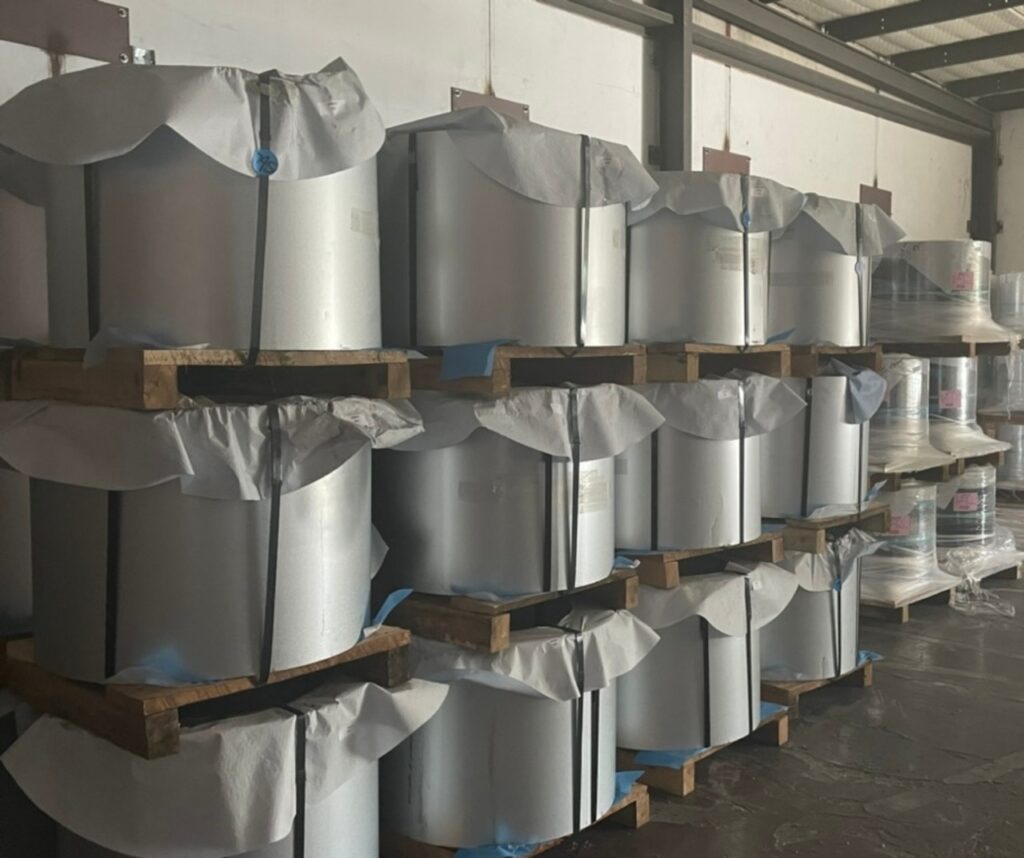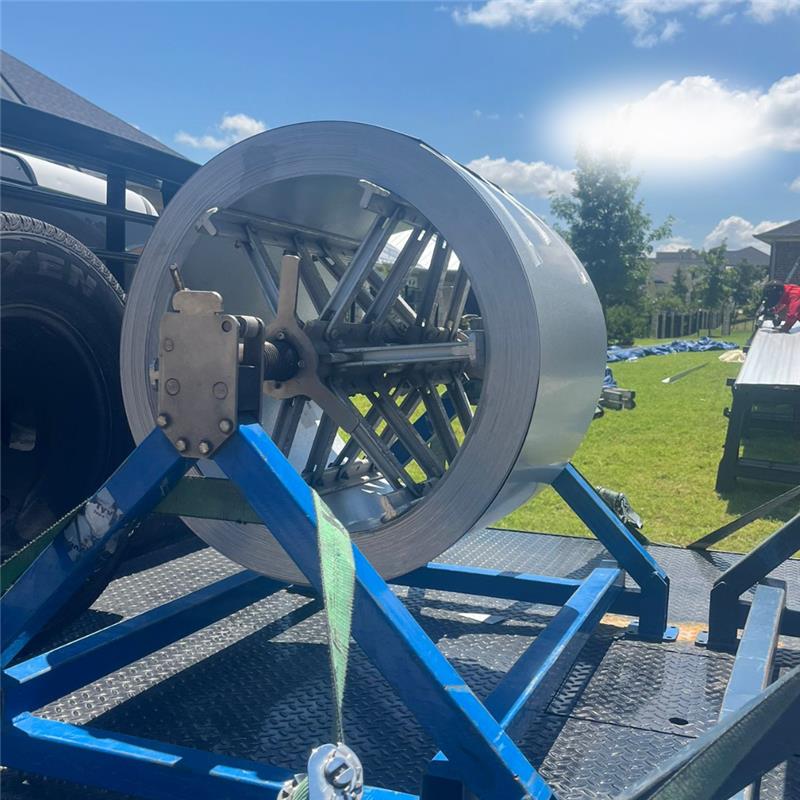Have you ever looked up at a sleek metal roof and wondered how it came to be? The journey from raw materials to the finished product protecting homes across San Antonio and beyond is both fascinating and complex. At the heart of quality metal roofing lies an unassuming yet crucial component: the steel coil. These massive rolls of metal serve as the foundation for the durable, weather-resistant roofing that’s becoming increasingly popular in modern construction.
Just as a master chef transforms basic ingredients into a gourmet meal, skilled manufacturers take these industrial-sized steel coils and, through precision engineering and specialized techniques, create roofing materials that can withstand decades of harsh weather while maintaining their beauty and structural integrity. Today, we’re pulling back the curtain on this remarkable transformation process.
Table of Contents
The Raw Material: Understanding Steel Coils
At the beginning of every metal roof is the humble steel coil – though there’s nothing truly humble about these massive industrial materials. Steel coils are essentially large rolls of flat steel that serve as the primary raw material for metal roofing production. These coils aren’t just any steel; they’re carefully formulated alloys designed specifically for construction applications.
The Composition of Quality Steel Coils
The journey begins at steel mills where iron ore, coal, and limestone are transformed through the smelting process into molten steel. This liquid metal is then cast into slabs, which are subsequently rolled into thinner and thinner sheets until they reach the desired thickness – typically between 0.016 and 0.05 inches for roofing applications. The resulting sheets are then coiled into the massive rolls that will eventually make their way to roofing manufacturers.
What makes these steel coils special is their precise composition. Many roofing-grade steel coils contain specific amounts of zinc and aluminum, which enhance the material’s corrosion resistance. This metallurgical science ensures that the final roofing product can withstand decades of exposure to the elements.
Grades and Types of Steel Used in Roofing
Not all steel coils are created equal. Manufacturers select specific grades based on the intended application and regional weather conditions. For example:
- Galvanized steel coils feature a zinc coating that protects against rust and corrosion
- Galvalume steel coils contain a combination of zinc and aluminum, offering superior corrosion resistance
- Weathering steel coils develop a protective patina over time, making them ideal for certain architectural applications
The quality of these base materials directly influences the longevity and performance of the finished roof, which is why reputable manufacturers are exceedingly particular about their steel coil suppliers and specifications.
Initial Processing: Preparing Steel Coils for Production
Once the massive steel coils arrive at the manufacturing facility, the transformation process begins. These industrial-sized rolls, which can weigh upwards of 10,000 pounds each, require specialized equipment just to move and position them for the initial processing stages.
Uncoiling and Inspection
The first step involves carefully mounting the steel coil onto an uncoiler – a machine designed to safely and evenly feed the steel into the production line. During this stage, the material undergoes its first quality inspection. Technicians examine the steel for any imperfections, inconsistencies in thickness, or damage that might have occurred during transportation.
Tension Leveling and Flattening
After inspection, the steel passes through a series of rollers in a process called tension leveling. This critical step removes any memory or tension that exists within the coiled steel, essentially “training” the metal to lie flat. Without this process, the natural tendency of the steel to retain its coiled shape would make it impossible to form into straight, uniform roofing panels.
Precision is paramount during this stage. Even minor inconsistencies in tension or flatness can lead to problems during subsequent manufacturing steps or, worse yet, performance issues after installation.
The Cutting Stage: From Coil to Manageable Sheets
With the steel coil now properly tensioned and flattened, it’s time to transform the continuous sheet into workable pieces that will eventually become roofing panels or shingles.
Precision Cutting Technology
Modern metal roofing manufacturers employ computer-controlled cutting systems that ensure exact dimensions and clean edges. Depending on the final product being made, the steel may be cut into:
- Long panels for standing seam applications
- Wider sheets for stamping into shingle-style products
- Precise shapes for specialty architectural elements
The cutting equipment used in this process has evolved dramatically over the years. What once required labor-intensive manual measurement and cutting is now handled by automated systems that can maintain tolerances within fractions of millimeters.
Reducing Waste Through Optimization
Efficiency isn’t just about speed – it’s also about minimizing waste. Advanced manufacturing software maps out the most efficient cutting patterns to maximize the usable material from each steel coil. This not only reduces production costs but also makes the manufacturing process more environmentally sustainable by minimizing scrap.
Profiling and Forming: Creating the Roof’s Shape
With properly sized pieces cut from the original steel coil, the next step transforms flat metal into the distinctive shapes and profiles that give metal roofing its structural strength and aesthetic appeal.
Roll Forming for Panels
For many types of metal roofing, especially standing seam styles, roll forming is the primary technique used. This process involves passing the flat sheets through a series of precisely configured rollers, each set gradually shaping the metal until it emerges with the desired profile.
The roll forming process requires exceptional precision. Each set of rollers must be perfectly aligned and calibrated to ensure the metal bends exactly as needed without creating undue stress on the material. The result is a uniform panel with consistent dimensions throughout its length.
Stamping and Pressing for Dimensional Products
For metal shingles and tiles that mimic traditional roofing materials, manufacturers use powerful stamping presses. These machines use custom dies to form the metal into three-dimensional shapes that can replicate the look of wood shakes, slate, or clay tiles.
The engineering behind these dies is remarkable – they must create complex shapes while maintaining the structural integrity of the metal. Too aggressive a stamp can weaken the material; too gentle won’t create the desired visual effect.
Protective Coatings: Ensuring Longevity
The structural forming may be complete, but the transformation from raw steel coil to finished roofing product is far from over. Now comes the critical application of protective coatings that will determine how the roof performs over decades of exposure to sun, rain, snow, and atmospheric pollution.
Galvanization: The First Line of Defense
Many steel coils arrive at the factory pre-galvanized, meaning they already have a zinc coating applied at the steel mill. However, some manufacturers apply additional galvanization during their process for enhanced protection.
The science behind galvanization is fascinating – zinc actually sacrifices itself to protect the underlying steel through a process called cathodic protection. When exposed to the elements, the zinc corrodes first, saving the structural steel from deterioration.
Primers and Undercoatings
After forming and any additional galvanization, roofing panels receive specialized primers designed to:
- Enhance adhesion of subsequent paint layers
- Provide an additional moisture barrier
- Prevent chemical reactions between the metal substrate and topcoats
Quality manufacturers never skip this step, even though it’s invisible in the finished product. These undercoatings are crucial to the long-term performance of metal roofing.
Painting and Finishing: The Aesthetic and Functional Layer
The appearance of a metal roof is what homeowners see, but the paint system does far more than just provide color – it’s a crucial protective layer that shields the processed steel coil material from the elements.
High-Performance Paint Systems
Modern metal roofing employs sophisticated paint formulations specifically engineered for exterior building applications. These paints contain:
- Resin systems that provide flexibility and adhesion
- Pigments that offer color stability against UV radiation
- Special additives that enhance dirt resistance, reflectivity, and other performance characteristics
The best manufacturers use PVDF (polyvinylidene fluoride) coatings – commonly known by brand names like Kynar 500® or Hylar 5000® – which can maintain their color and protective properties for decades.
Application Techniques for Durability
Applying these finishes requires specialized equipment and carefully controlled conditions. Coil coating lines apply the paint to the metal while it’s still in sheet form, before it’s formed into roofing profiles. This ensures complete, uniform coverage that would be impossible to achieve after forming.
The coating process typically includes multiple passes through cleaning stages, pretreatment applications, primer coats, and finally the color topcoat – all cured in high-temperature ovens to create a finish that becomes chemically bonded to the metal substrate.
Quality Control: Ensuring Perfection at Every Stage
The transformation from steel coil to finished metal roofing includes rigorous quality testing throughout the manufacturing process. These checks ensure that every panel or shingle that leaves the factory meets exacting standards.
Physical Testing
Quality control technicians regularly perform tests to verify:
- Thickness uniformity across panels
- Dimensional accuracy of profiles and formed edges
- Bend quality at seams and transitions
- Panel strength through load testing
These physical tests ensure that the roofing will perform as expected when installed on a building.
Finish and Coating Verification
Equally important is verifying the quality of protective and decorative finishes:
- Adhesion testing confirms that coatings won’t peel or flake
- Impact resistance tests ensure the finish can withstand hail and falling debris
- Salt spray exposure simulates years of weathering in accelerated time
- Color consistency checks maintain aesthetic uniformity across production batches
Leading manufacturers maintain detailed records of these tests, creating a quality trail that follows each production run from the original steel coil through to finished product.
Packaging and Transportation: Getting Ready for Installation
Once manufacturing is complete, proper packaging becomes crucial to ensure that the finished products – transformed from raw steel coils into precision building materials – arrive at construction sites in perfect condition.
Protecting the Finished Product
Metal roofing panels are typically:
- Interleaved with protective film or paper to prevent scratching
- Stacked in specific sequences that prevent deformation
- Bound securely to prevent shifting during transport
- Wrapped in weather-resistant coverings for outdoor storage
The care taken during packaging reflects the manufacturer’s understanding that damage during shipping can compromise a product that was perfectly made.
Logistics and Delivery Considerations
Delivering metal roofing requires specialized handling:
- Flatbed trucks for long panels that can’t be bent
- Careful loading sequences that distribute weight properly
- Strategic delivery timing to minimize on-site storage time
- Precise offloading procedures that protect panel edges and finishes
The journey from factory to installation site is the final step in the manufacturer’s responsibility, but it’s handled with the same attention to detail as every step that came before.
Environmental Considerations in Metal Roof Manufacturing
The transformation of steel coils into roofing materials has significant environmental implications – many of them positive when compared to other roofing options.
Energy Efficiency in Production
Modern metal roofing production has become increasingly energy-efficient:
- Heat recovery systems capture and reuse thermal energy from coating ovens
- Variable speed motors reduce electricity consumption during periods of lower demand
- Process optimization minimizes the energy required to transform materials
Forward-thinking manufacturers continuously invest in technologies that reduce the carbon footprint of their operations.
Recyclability and Material Usage
Perhaps the greatest environmental benefit of metal roofing is its recyclability:
- Most metal roofing contains a significant percentage of recycled steel
- At the end of its useful life (often 50+ years), metal roofing is 100% recyclable
- The manufacturing process produces minimal landfill waste compared to asphalt shingle production
This closed-loop potential makes metal roofing, derived from steel coils, one of the most environmentally responsible roofing options available.
The Evolution of Metal Roofing Technology
The process of transforming steel coils into roofing has evolved dramatically over time, with continuing innovations improving both the manufacturing process and the finished product.
Historical Perspective
Metal roofing has a rich history:
- Early metal roofs were hand-formed by skilled craftsmen
- The industrial revolution brought the first mechanized production
- Mid-20th century innovations introduced continuous roll forming
- Computer control systems revolutionized precision and consistency
Today’s manufacturing processes would be unrecognizable to metalworkers of previous generations, though the fundamental goal remains the same: creating durable, weather-resistant roofing from sheet metal.
Recent Innovations
The pace of innovation continues to accelerate:
- Advanced metallurgy creates steel alloys with enhanced properties
- Nano-technology in coatings provides self-cleaning and air-purifying capabilities
- Solar-reflective pigments dramatically improve energy efficiency
- Integration of photovoltaic technology merges roofing and energy production
These developments continue to expand the capabilities and performance of products that begin their life as humble steel coils.
From Factory to Rooftop: The Installation Process
While manufacturing transforms steel coils into roofing products, proper installation is equally crucial to the performance of the finished roof system.
Preparing for Installation
Before panels leave the factory, manufacturers often provide:
- Detailed installation instructions
- Specialized fastening systems designed for their specific profiles
- Technical support for installers
- Warranty information tied to proper installation techniques
This guidance ensures that the qualities built into the product during manufacturing are preserved during installation.
Professional Installation Requirements
The best metal roofing products require skilled installation:
- Precise measurement and layout
- Proper handling of panels to prevent damage
- Correct fastening techniques that allow for thermal movement
- Attention to flashing and transitions to ensure water-tightness
The transformation from raw steel coil to protective roof is only complete when the material is properly secured to the building it will protect.
Why Manufacturing Quality Matters for Metal Roofing
The rigorous process that transforms steel coils into finished roofing directly impacts the performance homeowners can expect from their investment.
Longevity and Life-Cycle Cost
Quality manufacturing results in:
- Roofing that maintains its appearance for decades
- Structural integrity that withstands extreme weather events
- Finishes that don’t require regular reapplication
- Systems that can last 50+ years with minimal maintenance
The initial cost difference between premium and economy metal roofing often becomes insignificant when spread across the product’s full lifespan.
Performance Under Extreme Conditions
The true test of manufacturing quality comes during severe weather:
- Precisely formed panels resist wind uplift during storms
- Quality coatings prevent corrosion in harsh environments
- Proper material formulation allows flexibility without cracking in temperature extremes
- Consistent manufacturing ensures uniform performance across the entire roof surface
These performance attributes all trace back to decisions made during the manufacturing process, from the selection of the base steel coil to the final quality inspection.
The Future of Metal Roofing Production
As we look ahead, the transformation of steel coils into roofing products continues to evolve in response to changing market demands and technological capabilities.
Automation and Industry 4.0
Manufacturing is becoming increasingly sophisticated:
- Artificial intelligence optimizes production parameters in real-time
- Robotics handle increasingly complex forming and finishing tasks
- Digital twins of production lines allow virtual testing of process improvements
- Connected sensors monitor every aspect of production quality
These technological advances are making metal roofing more consistent, more affordable, and higher performing.
Sustainability as a Driving Force
Future developments will increasingly focus on environmental impact:
- Water-based coating systems reduce VOC emissions
- Energy-neutral manufacturing facilities powered by renewable sources
- Closed-loop water systems eliminate manufacturing discharge
- Enhanced recycled content in base steel coils
The metal roofing industry is positioning itself as a leader in sustainable building materials, starting with its manufacturing processes.
Conclusion
The journey from steel coil to finished metal roofing represents an impressive convergence of metallurgical science, precision engineering, advanced chemistry, and quality control. This remarkable transformation process results in roofing products that offer unmatched durability, energy efficiency, and aesthetic versatility.
Understanding this manufacturing journey helps homeowners and building professionals appreciate why quality metal roofing commands a premium price – and why that investment pays dividends over decades of service life. The next time you look up at a beautiful metal roof, you’ll know that its origins began with massive steel coils and a sophisticated manufacturing process designed to create protection that lasts for generations.
FAQs
What makes some steel coils better than others for roofing applications?
Steel coils for roofing differ primarily in their metallurgical composition, coating types, and thickness. Premium roofing uses steel with precisely controlled amounts of zinc, aluminum, and sometimes silicon to enhance corrosion resistance. The thickness (measured in gauge or millimeters) also affects durability, with thicker materials generally offering longer lifespans but at higher cost and weight.
How does the manufacturing process affect the lifespan of metal roofing?
Every step in transforming steel coils into roofing impacts longevity. Proper tension leveling prevents future oil-canning (waviness), precise forming creates water-tight seams, and quality coating application determines UV and corrosion resistance. A roof manufactured with shortcuts in any of these areas may look similar initially but will show premature wear and potential failure long before a properly manufactured product.
Can metal roofing be made from recycled materials?
Yes, most steel coils used in metal roofing contain a significant percentage of recycled content – typically 25-30% and sometimes much higher. Steel is unique among building materials in that it can be recycled indefinitely without degradation in quality, making metal roofing one of the most environmentally responsible roofing options available.
How do manufacturers ensure consistent color across different production batches?
Color consistency across multiple steel coil batches requires sophisticated quality control. Manufacturers use spectrophotometers to measure the exact color values of each production run, maintain detailed records of paint formulations, and often reserve specific paint batches for large projects that may require future additions. Even so, slight variations can occur, which is why professional installers typically mix panels from different bundles during installation.
What innovations have most improved metal roofing in recent years?
Recent advancements include cool-roof pigment technology that dramatically increases solar reflectance, locking panel systems that eliminate exposed fasteners, enhanced substrate formulations that improve hail resistance, and sophisticated paint systems that resist microscopic dirt adhesion. All these innovations begin during the transformation of steel coils into finished products and contribute to metal roofing’s growing market share.
How do manufacturers test the weather resistance of their products?
Quality manufacturers subject their finished products to accelerated weather testing that simulates decades of exposure in just months. These tests include QUV accelerated weathering (which simulates intense UV exposure), salt spray testing (for coastal applications), impact testing (for hail resistance), and wind uplift testing. All these performance characteristics depend on how well the original steel coil has been transformed through the manufacturing process.
Why does metal roofing from different manufacturers vary so much in price?
Price differences reflect variations in raw materials, manufacturing processes, and warranties. Premium manufacturers use higher-grade steel coils, more sophisticated coating systems, and more rigorous quality control – all of which increase costs but deliver superior performance. Additionally, companies that stand behind their products with comprehensive warranties have factored that long-term responsibility into their pricing.
How does the metal roofing manufacturing process differ from asphalt shingle production?
Unlike the petroleum-based process of creating asphalt shingles, metal roofing production begins with steel coils and uses primarily mechanical forming rather than chemical processes. Metal roofing manufacturing consumes significantly less energy, produces minimal waste, creates products with 3-4 times longer lifespan, and results in materials that are 100% recyclable at end-of-life – making it inherently more sustainable.
Can manufacturers create custom colors for metal roofing projects?
Yes, many manufacturers can produce custom colors beyond their standard offerings, though typically with minimum order requirements. The process involves creating a custom paint formulation that can be applied during the coating phase of transforming steel coils into finished panels. Custom colors are particularly common for architectural projects, commercial applications, and historic restorations requiring specific color matching.
What should consumers look for to identify quality metal roofing products?
Quality indicators include the manufacturer’s warranty (particularly finish warranties of 30+ years), the paint system used (PVDF/Kynar 500 being premium), metal thickness (typically 24-26 gauge for quality residential products), and coating thickness measurements (often listed in “mils”). Together, these specifications reveal how thoroughly the manufacturer has invested in transforming basic steel coils into superior roofing products that will perform for decades.
——————-
With more than 50 years of experience in manufacturing and metal roof installation, Fasteel – Metal Roof Solutions designs, manufactures, and distributes metal roofing products, including coils, flat sheets, panels, trims, and accessories. Our services include breaking metal, on-site manufacturing, small batch production, and plans and blueprint interpretation to ensure the most accurate estimate. With manufacturing facilities and warehouses in San Antonio and Houston, we cover the entire Dallas, Austin, San Antonio, and Houston metroplex area. In addition, we have a fleet of high-tech roll formers that allows us to expand our coverage to anywhere in the continental United States of America.






